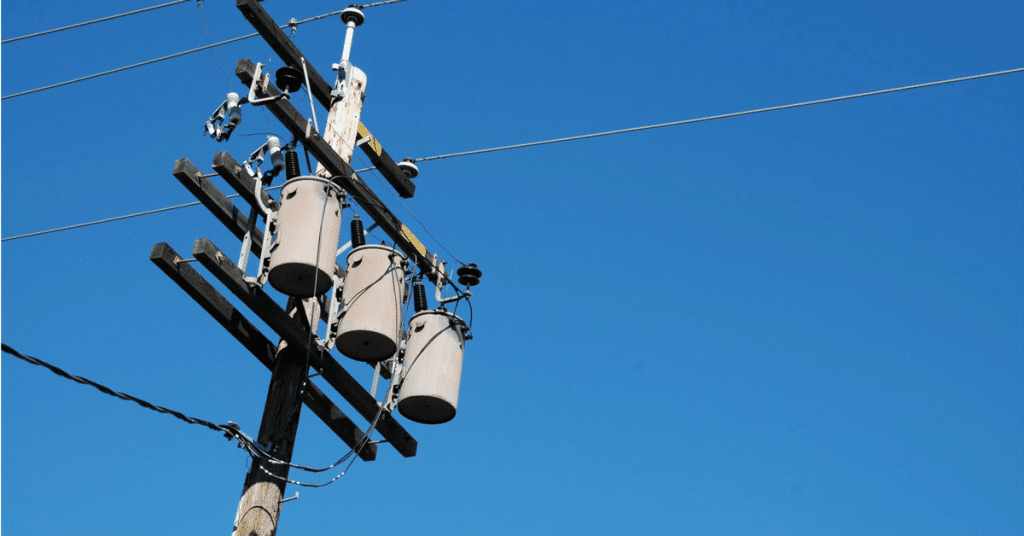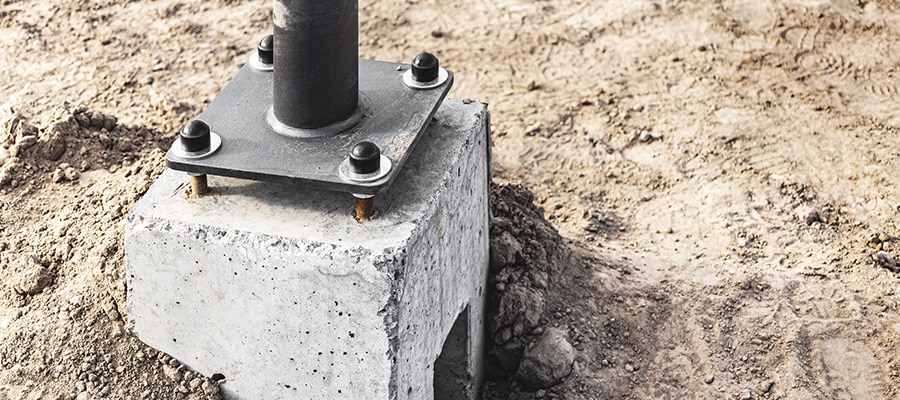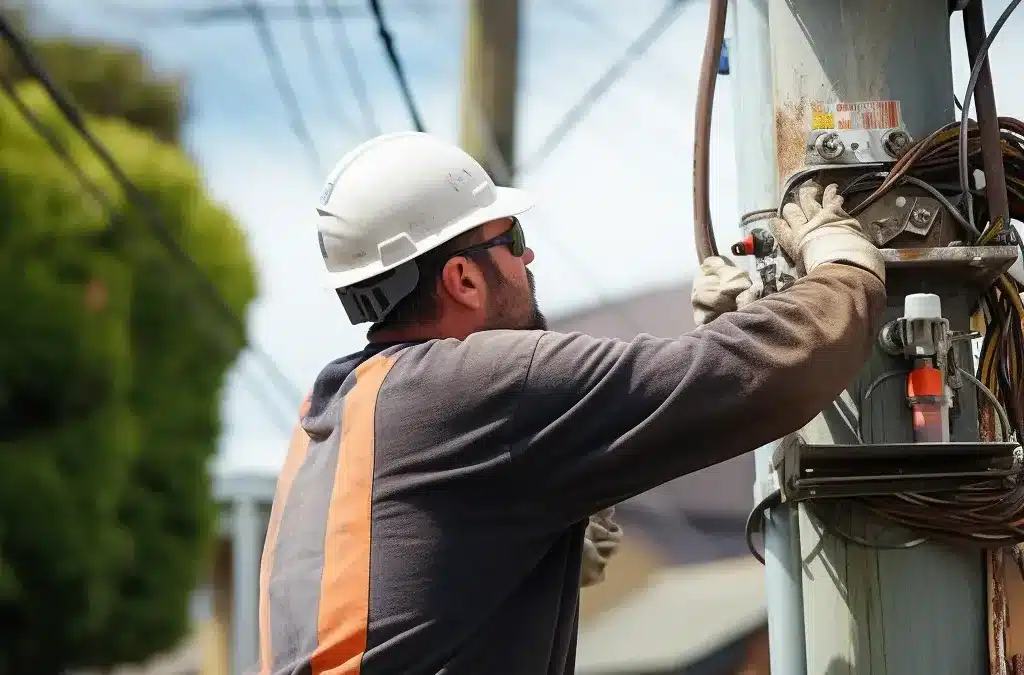We, at The Local Electrician, are devoted to transforming lives and enhancing convenience. In this important task, electricity poles play a critical role in serving hilltop communities.
Bringing electricity to remote mountain tops isn’t without challenges. It requires dedication, planning and technical knowledge to install and repair these essentials of modern living.
In this post, we explore the significance of these infrastructures, enabling comfortable hilltop living. Let’s turn our gaze towards the towering friends that keep our lights on.
What are Electricity Poles?

Their main job is to carry power lines across great distances, ensuring electricity reaches every dwelling.
You wouldn’t want your Netflix binge disrupted just because you chose a picturesque hilltop abode, would you?
- Power Distribution: They distribute power from substations to your homes or business premises.
- Cable Support: They support cables at a safe height for humans and vehicles.
Installation and repair of these poles require proficiency and precision as incorrect installation might result in severe outages or safety risks.
“Service to mankind is service to God”
Energizing Hilltop Living
Electricity poles are more than pieces of infrastructure; they embody progress reaching even the remotest corners of our world.
Hilltop living poses unique challenges due to rough terrain and altitude. Our skilled team makes even these tough tasks look easy.
The role of electricity poles in hilltop communities is of utmost significance as living in beautiful heights should not mean giving up modern conveniences.
Ensuring Connectivity: Journeying to incredible heights, these poles ensure link-ups to the modern world.
Assuring Safety: Constructed to withstand nature’s various elements, they offer secure, reliable power delivery.
Their presence ensures a comfortable hilltop living experience packed with convenience and devoid of any compromise. Note: It’s critical to understand that poles’ setup in hilly regions requires meticulous planning and execution due to challenging terrains.
Planning for Pole Installation

Surveying the Topography
The hilly topography proves a challenge in installing electrical poles. A comprehensive land survey can help navigate through steep slopes, inclement weather conditions and distinctive plant life.
Sourcing Local Materials
Often conducted simultaneously with surveys, sourcing of local materials like wood or concrete for pole installation has benefits. It cuts down logistical costs and promotes community involvement and livelihood.
Overcoming Access Difficulties
Hilltops often have limited accessibility, causing transport difficulties in delivering heavy poles. Resolving these constraints could involve using small, unpaved roads, enlisting local manpower or utilizing animal-drawn carts.
Poles Supporting T1 Repeaters
The role that electrical poles play extends beyond just power delivery. They also support T1 Repeater installations which form the basis of our modern telecommunication infrastructure.
Promoting Telecommunication Access
T1 Repeaters generate strong signals to establish successful communication networks even in remote hilltop areas. Electrical poles serve as physical support for these devices, creating a connected world despite the geographical hindrances.
Robust Construction
Using robust and durable materials is crucial due to the exposed nature of the poles. The extremes of weather they experience necessitates materials that can withstand those conditions while supporting T1 Repeaters.
Managing Maintenance
Maintenance of these T1 Repeaters is also vital. Scheduled inspections and quick response repair crews guarantee uninterrupted hilltop communication.
Space Allocation on Joint Poles
The design of electricity poles for hilltop living involves strategic space allocation. Several utilities often rely upon the same infrastructure, termed “joint poles”.
Generally, these joint poles accommodate:
- Electricity lines: Found at the top, they deliver power to homes and businesses.
- Telecommunication lines: Positioned underneath electric wires, they facilitate internet and phone services.
- Cable TV wires: Located near the bottom, they transmit television channels.
The electrical companies usually own these poles and lease space to other service providers. Space allocation significantly affects the utility of a pole.
Cost Analysis of Poles
A critical aspect when considering these structures is the cost. The fabrication and installation of electricity poles require substantial financial investments.
To optimize costs, electricity companies must balance initial investment against recurring maintenance and potential replacement expenses.
Impact of Electricity Poles
Electricity poles significantly influence hilltop living. They not only facilitate electricity supply but also play a pivotal role in transforming the community lifestyle.
Infrastructure Development
Electricity poles help in developing infrastructure on hilltops. They provide the basic necessity, power, which fuels the growth and progression of these areas.
Lifestyle Transformation
With the introduction of electricity poles, hilltop residents experience lifestyle transformations. Electric power ignites modern amenities that enhance comfort and convenience.
Regulation and Compliance
Regulation and compliance also play a crucial role in installing electricity poles in hilltop areas. Adherence to these measures ensures safety and efficiency.
Safety Standards
Implementing safety standards during installation prevents accidents and ensures longevity of the poles. These guidelines ascertain that the poles are properly grounded and structurally sound to withstand extreme weather conditions.
Environmental Compliance
Installation of electricity poles must comply with environmental regulations to prevent degradation of natural habitats. This adherence not only secures the environment but also strengthens community relations.
Effective Communication Strategies
 The establishment of robust communication between utility companies and hilltop homeowners is essential. Clarity ensures seamless navigation of technicalities and facilitates a better understanding.
The establishment of robust communication between utility companies and hilltop homeowners is essential. Clarity ensures seamless navigation of technicalities and facilitates a better understanding.
- Regular Updates: Electricity companies ought to brief residents on planned infrastructure upgrades or adjustments.
- Damage Reporting: Residents should be promptly informed about how and where to report potential damages to electricity poles.
- Gather Feedback: Channels for gathering customer feedback can help monitor satisfaction levels and uncover latent issues.
The implementation of these strategies serves to alleviate consumer concerns, as well as enhance the reliability of hilltop electrification.
Education on Hilltop Electrification
Acknowledging the necessity for hilltop electrification solutions, it’s vital that educational programs are made available to residents. These initiatives foster a better understanding of the technologies implemented.
Safety sessions equip homeowners with tips for maintaining optimum output levels. Furthermore, education can help encourage more sustainable energy use.
Knowledge sharing workshops provide information about electricity pole maintenance during adverse weather conditions. Additionally, these serve as a platform to explain emergency procedures in case of power outages or electric faults.
Closing Thoughts
The scaling heights of electrical poles illuminates not just our homes but also symbolizes the height of human ingenuity. With effective communication strategies such as regular updates, damage reporting, and feedback systems, residents can actively contribute to the smooth operation of hilltop electrification.

